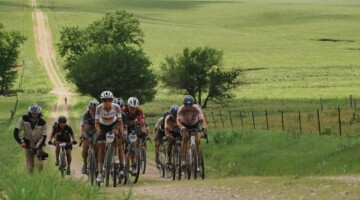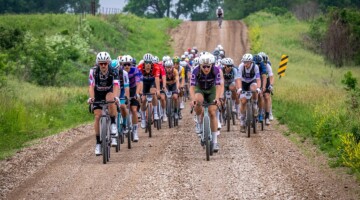
Our coverage of the 2018 Dirty Kanza 200 is brought to you in part by Panaracer. Check out its line of gravel tires for your next adventure.
Thanks to former Cyclocross Magazine editor Josh Patterson, this publication has covered the Dirty Kanza 200 gravel race in Kansas’ Flint Hills dating back to 2008 when the race was in its infancy. The event has picked up a few extra participants since then, but at its core, the Dirty Kanza is still about riding scores of miles of the famed Flint Hills gravel with, as Sven Nys put it, gravel friends who are “a little bit insane.”
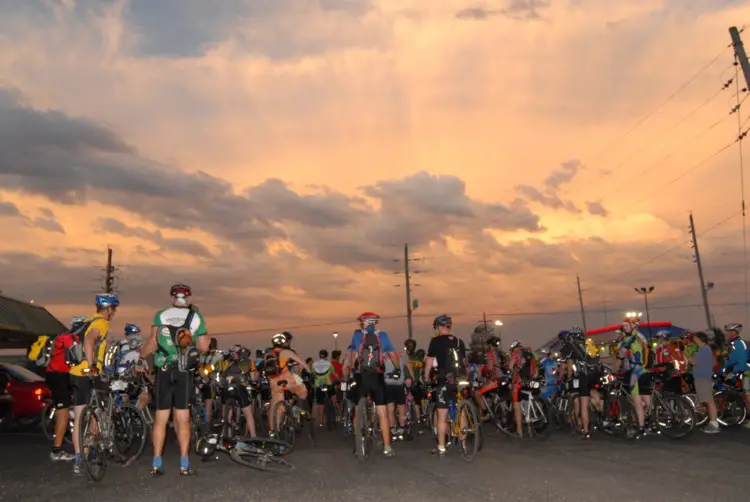
Cyclocross Magazine has covered the Dirty Kanza since 2008, when the start looked a bit different than it does today. photo: imdesigngroup.com
Despite covering the event from its early days, Cyclocross Magazine has never made it to the event to take in the scene, pre-Summer Kansas heat and great gravel racing. That changed this year when your humble editor packed up his rental car and headed to the Flint Hills of Kansas to cover the 2018 Dirty Kanza 200.
From a cyclocross perspective it was the perfect year, with Kaitie Keough and Amanda Nauman expected to battle for the Women’s title, Sven Nys making an appearance and the Canadian troika of Geoff Kabush, Craig Richey and Michael van den Ham targeting the Men’s race. At the same time, as we have expanded our gravel coverage the last few years, names like Mat Stephens, Ted King, Alison Tetrick, Olivia Dillon and more have also become familiar names on our pages. I am always a fan of a good story, and with so many top-level riders heading to this year’s DK200, there were certain to be plenty of them.
As the premier gravel event in the country, the Dirty Kanza has received a growing amount of attention each year, and as a result, many words have been written about the event in publications big and small. Since returning, folks have asked me my thoughts about the event, and my tl;dr response, if you are looking to save time, is “Great event. Incredible energy. Not sure I ever want to do the 206-mile ride.”
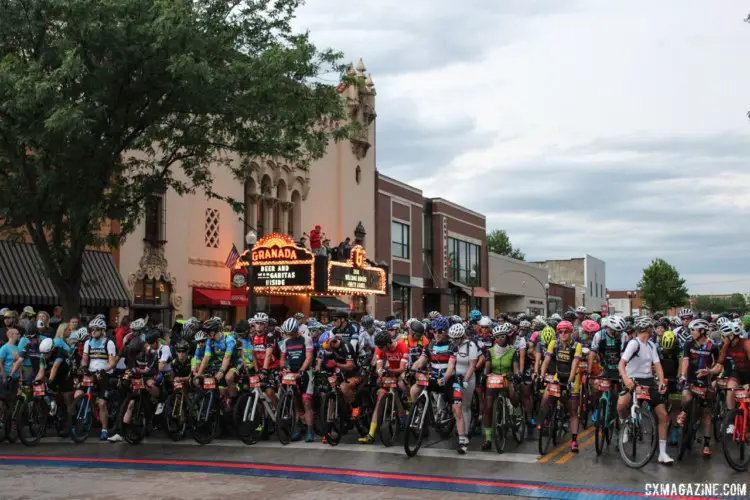
The Dirty Kanza 200 has grown a bit since it started. 2018 Dirty Kanza 200. © Z. Schuster / Cyclocross Magazine
For more extensive musings from Kansas, I’ve compiled some thoughts on and photos from the Dirty Kanza experience. For the record, my forte is writing—and I am sure some readers would argue I suck at that too—so for much better photos, I recommend checking out frequent CXHairs cyclocross contributor Ethan Glading’s gallery.
Too Much Success?
Any time a business bills itself as the world’s best whatever, chances are good the boast will fall flat. After all, there can only be one best burger in the world and it’s probably not at the random roadside diner you just stopped at.
When the Dirty Kanza bills itself as “The World’s Premier Gravel Grinder,” there are few gravel enthusiasts who would take umbrage with the boast. The Dirty Kanza started in 2006 when race director Jim Cummins and Joel Dyke wanted to put on a gravel grinder through Kansas’ Flint Hills. The first event had 34 riders and this year, participation was capped near 2,300 with a lottery held due to overwhelming demand for participation.
From a racing perspective, the Dirty Kanza 200 has become the most prestigious event on the non-existent gravel pro tour. Although the event has no cash prizes, earning the title of Queen or King of the Dirty Kanza is worth who knows how much in race payouts.
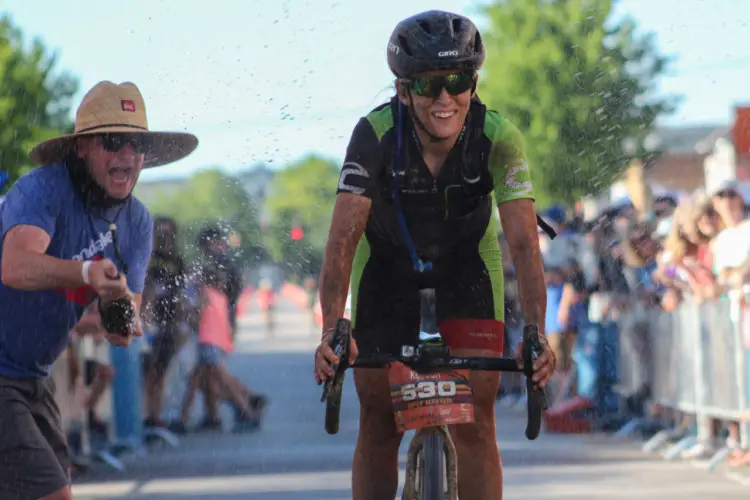
Getting to cross the line as the Queen of Dirty Kanza is something more and more current and former pros are aspiring to do. © Cyclocross Magazine
For amateurs, the Dirty Kanza race has taken on a life of its own. Two-hundred six miles of ruthless gravel (more on that later) in often sweltering conditions is a test of physical endurance that is uh, really difficult. Riders who have conquered their local 100-milers and now, won the entry lottery, make the pilgrimage to Emporia for what is the mecca of gravel cycling.
There is no question the Dirty Kanza is at an interesting place in its impressive existence. Like basically every other gravel grinder, it started as a grassroots event with some people gathering to ride their bikes on gravel roads, long before the gravel industrial complex was a thing. As the event has grown, it has taken on a paid staff while still trying to maintain the grassroots feel that is one of the core appeals of the gravel discipline. At the Elite level, more and more current and former pros are dipping their toes in the gravel waters and targeting the coveted Kanza titles.
The Dirty Kanza has long since gone from indie band to major label mainstay, but with so much more attention and interest, can it retain the core soul of what got it to the top? (Zach’s analogy skills: 1/10, would not recommend) Can an event still be grassroots while taking on a professional tenor? Can a gravel event get too big for the self-regulated, laid-back nature that makes it so appealing to the gravel crowd? All good questions, and certainly worth considering for a gravel scene and community that seems destined to grow over the next several years.
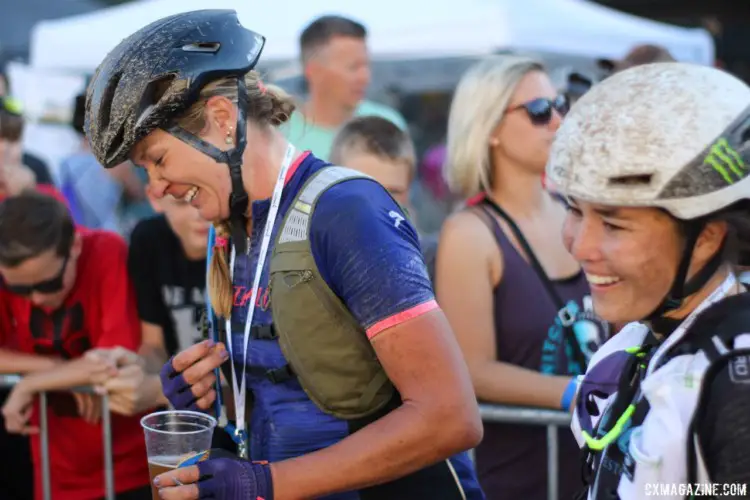
Can an event that attracts the Amanda Nauman and Alison Tetricks of the cycling world still be grassroots? That is one of the questions facing the Dirty Kanza. 2018 Women’s Dirty Kanza 200. © Z. Schuster / Cyclocross Magazine
Pre-Race Friday
Part of why the Dirty Kanza has become a gravel mecca is it is not just a race, it is an event. It is tempting to call it a long party, but I am pretty sure the race itself is anything but a party for most of the miles the athletes spend on their bikes.
Cummins and his Dirty Kanza team deserve a lot of credit for giving riders and their supporters a reason to come to Emporia early and stay through the weekend. Packet pick-up for riders is held downtown on Friday at the three-story Lyon County History Center. Although the event had literally thousands of people registered and five different race lengths, an impressive group of local volunteers helped direct traffic and get riders to the correct registration tables with little problems.
The volunteer I spoke with even knew where media credentials were being handed out. No one ever knows where the media credential table is!
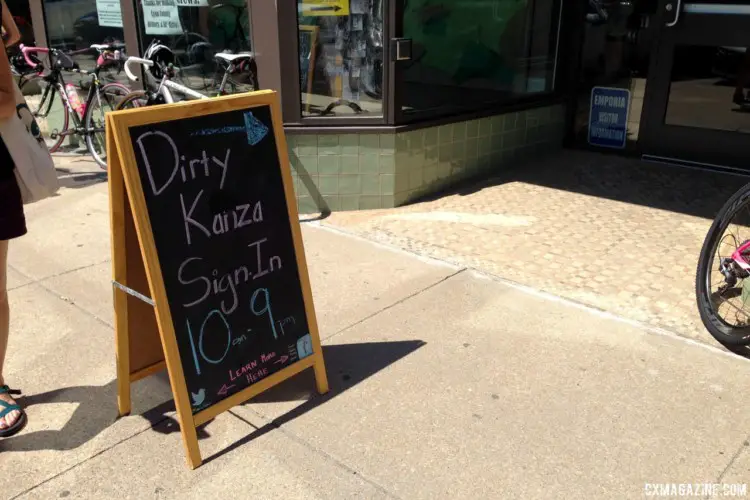
Registration was well-organized and easy to find. 2018 Dirty Kanza 200. © Z. Schuster / Cyclocross Magazine
Before I forget, I do not think it is a coincidence so many media outlets have made the trip to Kansas to cover the Dirty Kanza. I do not expect to be treated well or even as a valuable human being when I cover an event, but in a world where media is often an afterthought, the Dirty Kanza’s welcoming approach stands out. When I first applied for credentials, Cummins called the same day to let me know what help his team could provide, and the Dirty Kanza team actually enlists a local Jeep enthusiast club to drive photographers around during the race.
Media members are people too (shocking, I know), and showing some interest in having us at your event goes a long way.
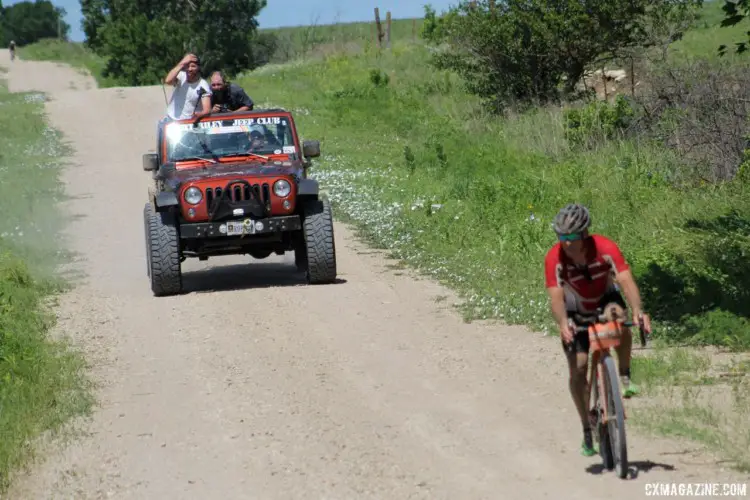
The local Jeep club provided rides for some race photographers. 2018 Dirty Kanza 200. © Z. Schuster / Cyclocross Magazine
The incredible energy in Emporia was palpable throughout the weekend. I don’t necessarily have the words to describe it, but everyone was really excited to be there and it was noticeable. The epicenter of this energy on Friday was the All Things Gravel Expo held across the street from packet pick-up. The Expo has grown every year, and word is it will only get bigger in the future.
A number of companies had products new and established on display at the Expo, but more importantly, it provided a place for the gravel crowd to congregate. The organizers did a great job organizing events with athletes and companies. When I arrived, Amanda Nauman, Alison Tetrick and Payson McElveen were chatting with fans and signing autographs, and later in the afternoon, Sven Nys made his rounds of the scene. Also, the famed Salsa Chaise couch was there, but it was very much look but don’t touch. You have to earn that photo on the gravel.
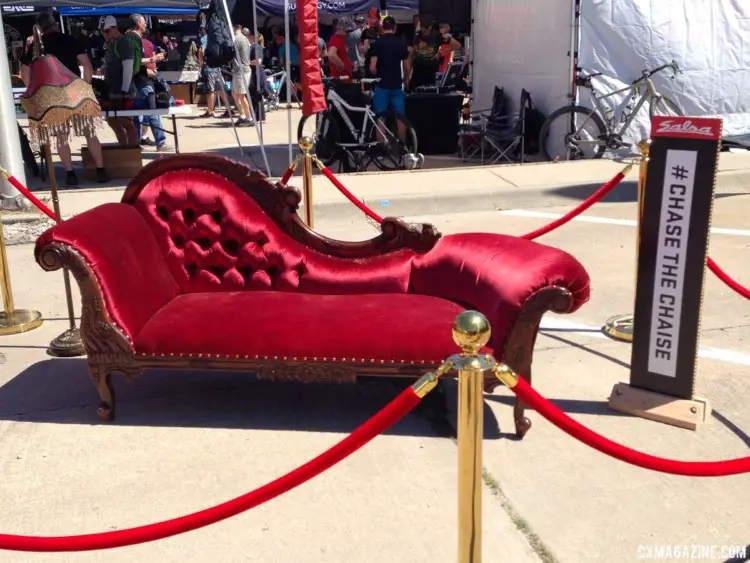
The Salsa Chaise couch hung out at the Expo on Friday. 2018 Dirty Kanza 200. © Z. Schuster / Cyclocross Magazine
The large Cannondale contingent was also soaking in the gravel scene. Former road pro Amber Pierce and Saturday’s winner Kaitie Keough threw down in a game of cornhole, and Ted King held court with the latest thing he learned about temperature regulation. Both Pierce and Ayesha McGowan noted how much they enjoyed the laid back nature of the gravel scene vis-à-vis professional road racing. The pros’ vibe at the Expo reminded me of Saturday at the Trek CX Cup last fall (along with the oppressive heat!) where CXM contributor Dave Mable cut his memorable Name That Wisconsin Town video.
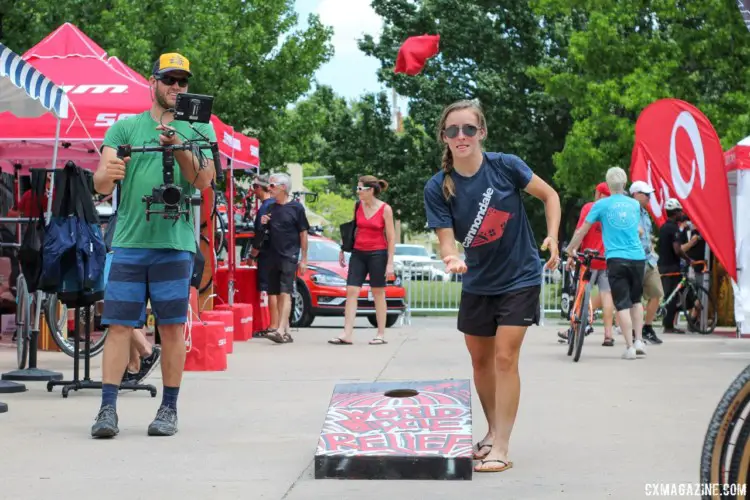
Keough and her teammates were relaxed on Friday before the race. © Z. Schuster / Cyclocross Magazine
The Real MVP
If there is a real MVP of the Dirty Kanza experience, it is not Kevin Durant’s mom, but rather the city of Emporia. Located southwest of Kansas City, Lawrence and Manhattan, Emporia is a medium-sized town of about 25,000 residents at the east edge of the famed Flint Hills. In a way, with a size that is not-too-big and an impressive downtown along Commercial Street, Emporia is the perfect setting for the start and finish of a massive gravel race.
Based on my incomplete experience with gravel events, I am convinced the level to which the host towns embrace the events contribute to their success. The town of Emporia wholeheartedly embraces the Dirty Kanza and helps provide an enthusiasm that takes the event to the next level.
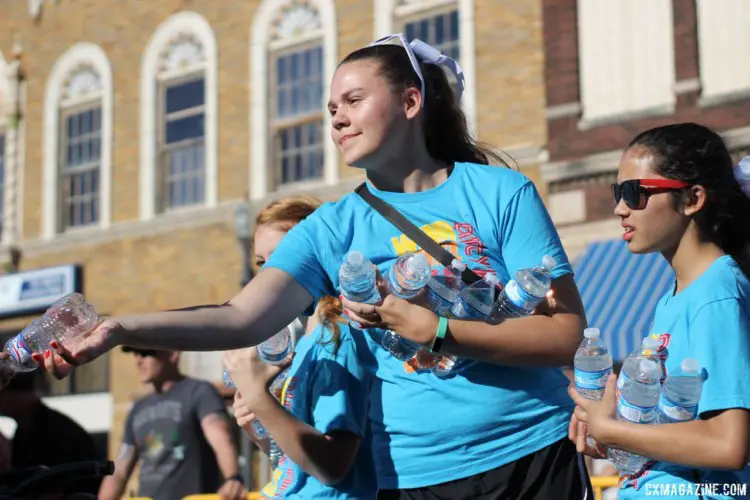
The light-blue-clad volunteers were the lifeblood of the Dirty Kanza’s success. 2018 Dirty Kanza 200. © Z. Schuster / Cyclocross Magazine
First and foremost, the volunteers are the people who make the Dirty Kanza run smoothly. Clad in light blue this year, the locals who chip in to help things run were hard to miss. Volunteers directed riders at packet pick-up, high-school cheerleaders helped riders wake up and get organized before the race at 6 a.m. on Saturday and others welcomed home riders with finisher cards after their gravel adventures.
Literally every business within a mile of Commercial Street (and farther out into the town) had signs welcoming Dirty Kanza riders. On Saturday morning, locals gathered all down the one mile stretch of Commercial Street to cheer riders on as they headed out toward the Flint Hills gravel. Coming home, riders were greeted by a blocks-long chute of cheering riders and fans to welcome them home.

Emporia businesses welcomed the Dirty Kanza riders to town with open arms. 2018 Dirty Kanza 200. © Z. Schuster / Cyclocross Magazine
While out on the course taking photos, I ran into a couple who rent a property out via Airbnb. They came out to (nondescript road outside Eureka) to look for the riders they were renting their property to and cheer them on. Another couple gathered at the Rocky Ford crossing of Walnut Creek to cheer riders on as they forded, rode and occasionally took a bath at the shallow crossing.
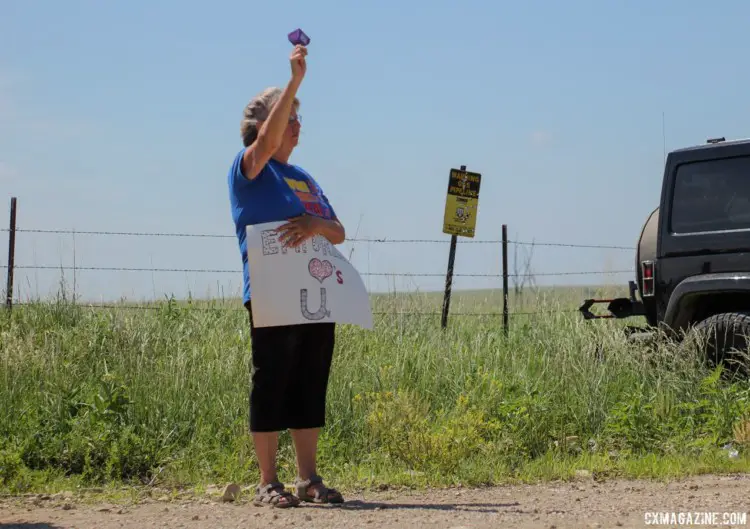
Even local Airbnb landlords came out to the gravel roads to cheer on their renters. © Z. Schuster / Cyclocross Magazine
In the end, I cannot say enough about how great the town of Emporia was. We all know cyclists are not always welcomed by communities big and small, and to see a town wholeheartedly embrace 2,000 lycra-clad gravel enthusiasts and welcome their presence was really cool to see.
Race Day Morning
After months of training, race day finally arrived for thousands of gravel riders on Saturday. With finishing times for the DK200 stretching to 16, 18 hours and beyond, the race starts early. Like really early. When I arrived at breakfast at 4:30 a.m. on Saturday, the coffee was already gone and folks were lined up to grab some calories to fuel their massive efforts.
As I groggily joined the enthusiastic riders heading to breakfast, the air was chilly and strong winds blew through the campus of Emporia State University. Outside town, lightning ripped through the still-dark evening. Despite the inclement weather, I did not hear any complaints about the weather. It was almost as if given Kanza’s notorious ruthlessness, all the riders had resigned themselves to dealing with whatever Mother Nature and the gravel gods threw their way. Needless to say, I was impressed. I, for one, would have been complaining.
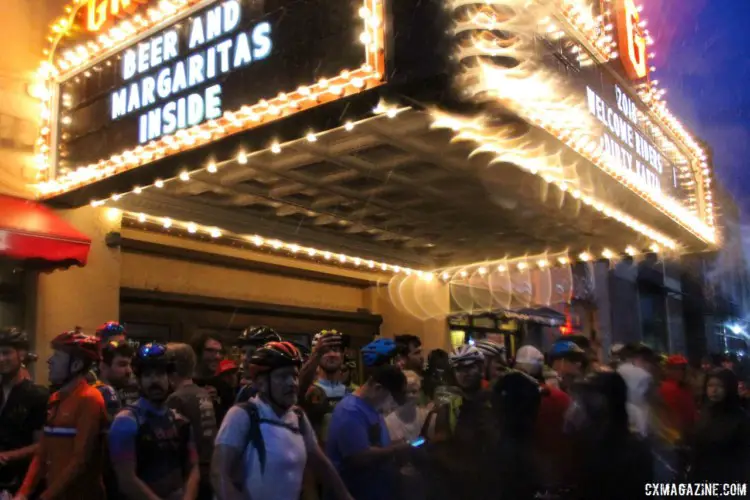
Rain and lightning caused a 30-minute delay and sent riders scrambling for cover. 2018 Women’s Dirty Kanza 200. © Z. Schuster / Cyclocross Magazine
When I arrived in downtown Emporia, I parked next to mountain bike star Payson McElveen. He recounted getting pelted by hail as he drove in from the East. He was most concerned about the DKXL riders out on the course overnight, but for himself, maybe it was some sort of protection provided by the mythical Red Bull helmet, but he seemed ready for the elements.
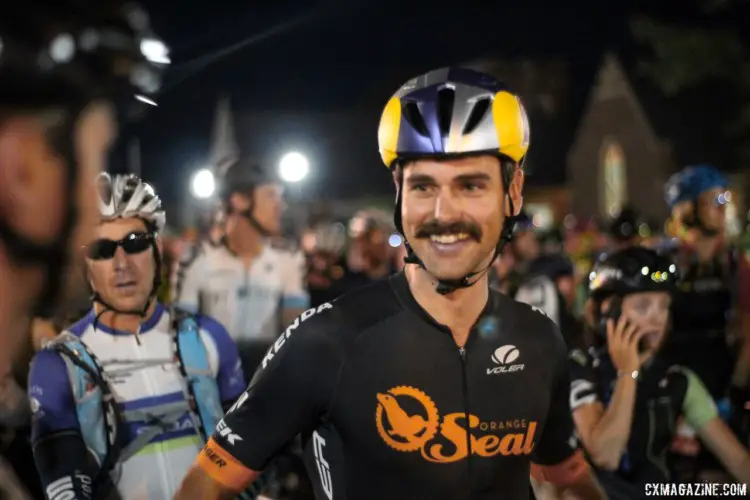
Perhaps the Red Bull helmet kept him protected from the elements, but Payson McElveen did not seem too concerned about the Saturday morning inclement weather. 2018 Dirty Kanza 200. © Z. Schuster / Cyclocross Magazine
With a 1,000-person field for the DK200 race, many riders started to line up early with the hopes of getting a prime position near the front of the field. Just after riders started congregating at 5:30 a.m., the rain started. Shortly thereafter, the announcer announced a 30-minute rain delay and all the riders sought cover under the marquee of the Grenada, in shops along Commercial Street and in whatever nooks and crannies they could find.
It was just rain, so maybe they were not all that prepared for the Kanza elements!
Of course, everyone left their bikes sitting in the middle of Commercial Street; they woke up early for those primo spots after all.
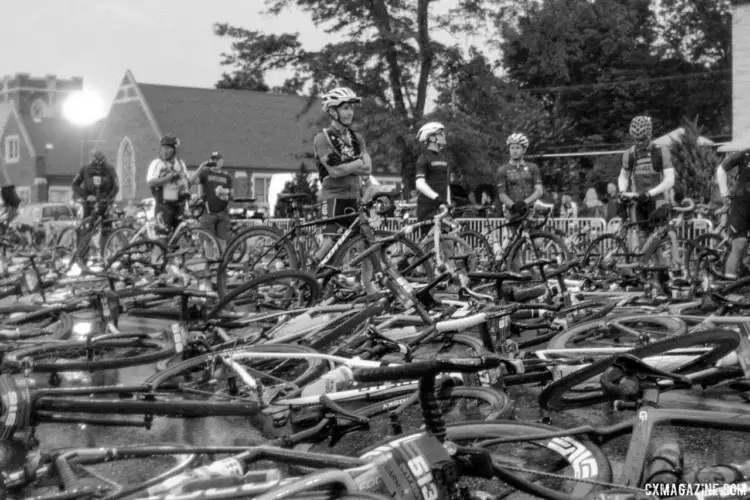
One by one, riders ventured out from their rain shelter and back to their bikes during the 30-minute delay before the start. 2018 Dirty Kanza 200. © Z. Schuster / Cyclocross Magazine
I mentioned the local cheerleaders earlier; the DK200 self-organizes the starting grid based on expected finish times. 12 hours, 14 hours, 16 hours and longer, riders self-select to ensure safe spacing once the field hits the first gravel road. This self-organizing approach is one aspect of the event that definitely leaned more “grassroots” than “corporate.” The cheerleading squad held up the finishing time signs so riders could organize themselves and provided some much-needed early morning enthusiasm.
Much needed for me at least; I am decidedly not a morning person.
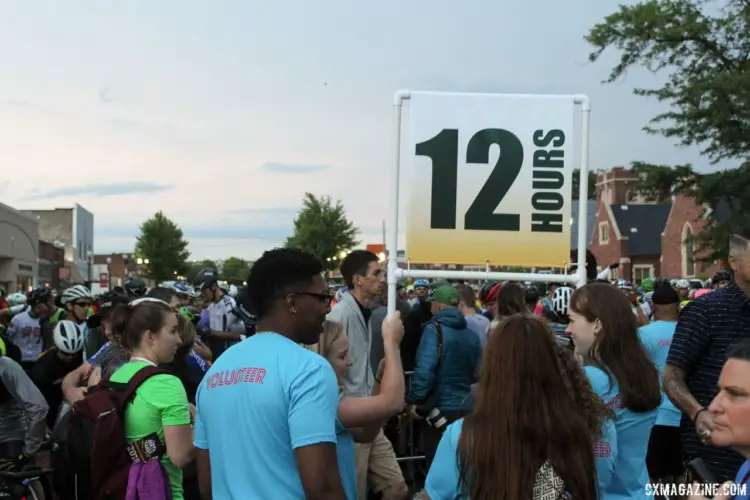
Cheerleaders from Emporia’s high school helped riders self-organize before the race. 2018 Dirty Kanza 200. © Z. Schuster / Cyclocross Magazine
With the start delayed, call-ups started around 6:20 a.m. Yes, there are call-ups at the DK200! I am not sure how qualifications are determined—unless there are some secret gravel UCI points I don’t know about—but whatever metrics they used seemed fair, as the eventual top three women and men finishers all received front-row call-ups.
Admittedly, I was hoping Sven Nys and Jens Voigt would be called up as Stanley Nice and Jon Vogt, respectively. For some reason, the Stan Nice thing still amuses me every time.
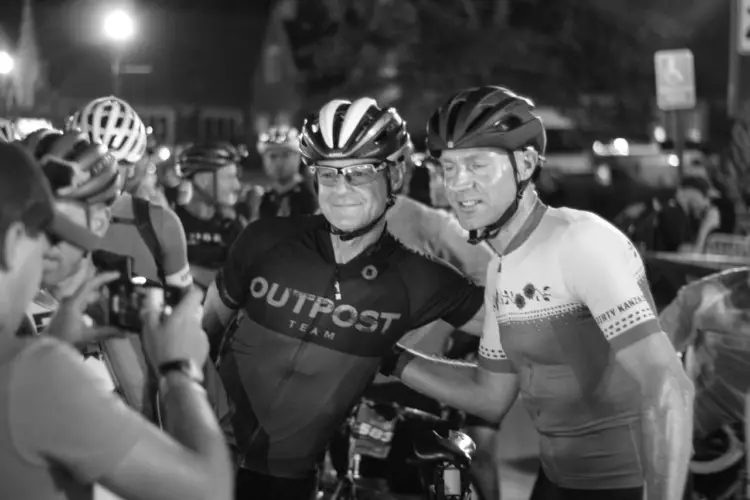
Jens Voigt took time to pose for a photo with a fan and fellow DK200 rider. 2018 Dirty Kanza 200. © Z. Schuster / Cyclocross Magazine
Anyway, race director Jim Cummins counted down the start and riders headed south down Commercial Street, past the fans gathered in the early morning to cheer them on and onto the gravel roads of the Flint Hills. After months of preparation and anticipation, the 2018 Dirty Kanza was finally here.
Flint Hills Gravel
Admittedly, as a rookie media member who either missed the memo or the cut to be part of the Jeep brigade, my experience of the famed Flint Hills gravel was limited by the spots I chose to stop. Kansas’ gravel roads have three different classifications from A to C. In what proved to be a stroke of luck, my car rental company upgraded me to one of those mini-SUV things that are popular right now over the compact car I requested
Even in a bigger, beefier vehicle, I was scared of flatting out of the race chase on the C roads. I can only imagine how horrible they are on a bike.
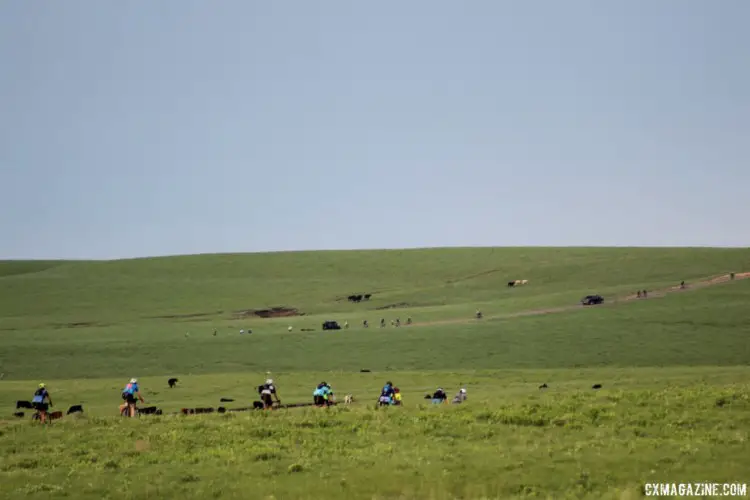
Riders, cows and cars wind their way through the Flint Hills. 2018 Dirty Kanza 200. © Z. Schuster / Cyclocross Magazine
Many of the photogenic views of the Dirty Kanza come from the first 50 or so miles of the race. Riders hit several steep climbs in the Flint Hills that are covered by a veneer of green that stretches for miles.
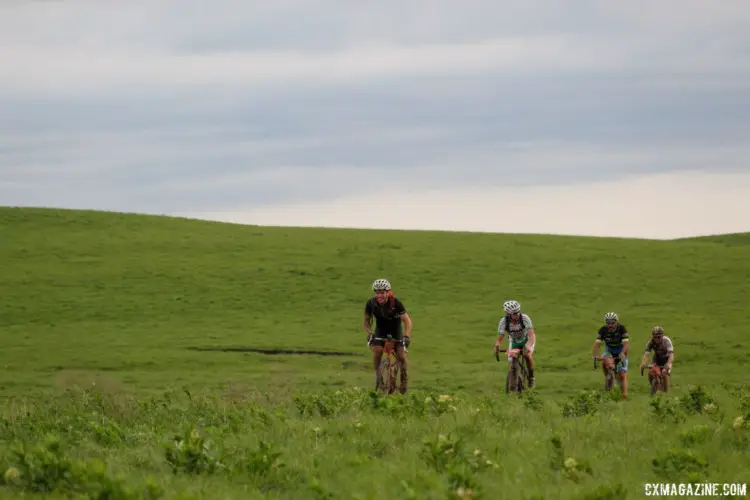
The Flint Hills are very green in parts, providing a pretty background for the first quarter of the course. 2018 Dirty Kanza 200. © Z. Schuster / Cyclocross Magazine
By a stroke of luck—or looking at a map and picking out a spot—I happened upon the descent off the first big climb of the race. Emporia local and producer of the Gravel Guru media platform Matt Fowler let me know I was in the right spot. “Media love this spot,” he told me. Me, to myself, “Nailed it!”
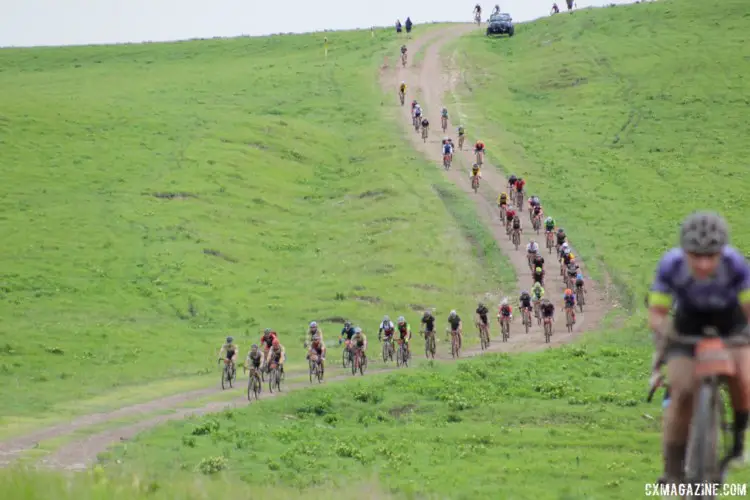
Riders roll down a descent near mile 20 that is popular with the media folks. 2018 Dirty Kanza 200. © Z. Schuster / Cyclocross Magazine
As riders passed 20 miles into the race, many were still in good spirits as the groups were compact and the pace was high. Many of them had already picked up some grit on the early course roads that are known for getting bogged down when the weather turns rainy.
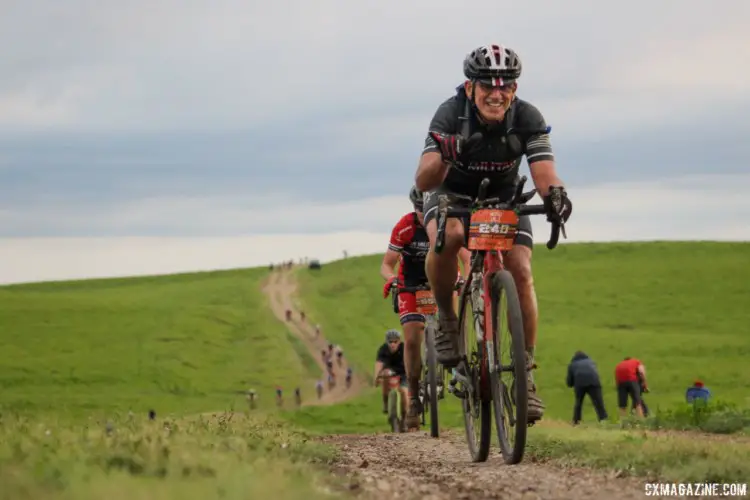
Riders were full of spirit early on at mile 20. 2018 Dirty Kanza 200. © Z. Schuster / Cyclocross Magazine
A large group of over 50 riders at the front was all business as they felt each other out and tried to deal with rough Kanza gravel.
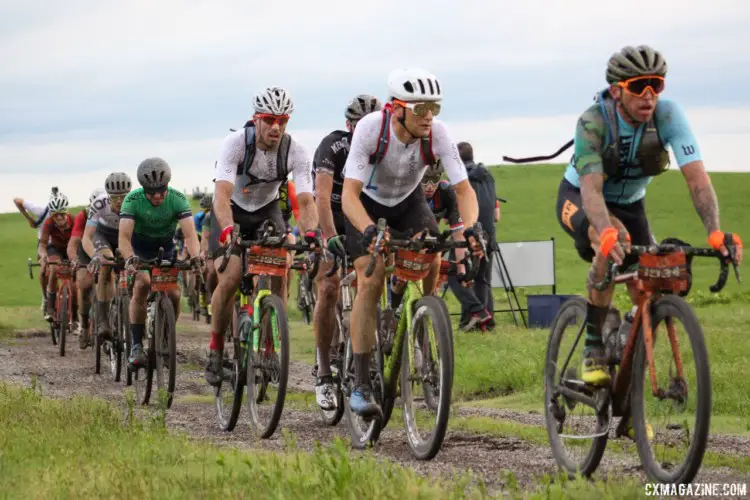
Ted King focuses in the lead group early in the race. 2018 Dirty Kanza 200. © Z. Schuster / Cyclocross Magazine
This week we covered the story of Sven Nys’ Dirty Kanza 200 and his run-in with the wrath of the Kanza gravel. Early in the race, the flat tires were hard to miss in the rest of the field as well, with several riders stopping to reinflate for the journey.
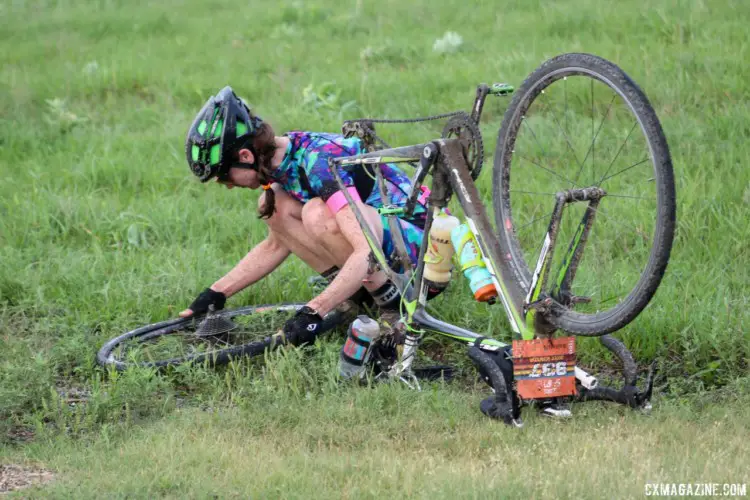
Flats, unfortunately, are unavoidable at the Dirty Kanza. 2018 Dirty Kanza 200. © Z. Schuster / Cyclocross Magazine
The weather on Friday was hot, with temperatures soaring into the 90s. If riders were not concerned about the inclement weather early Saturday morning, it may have been because the rains brought cooler temperatures. However, as the race moved into its middle half, the Kansas heat was back and temperatures inched back up toward the 90s. It was not as hot as Friday, but it was still pretty warm.
When I saw the riders out on the course again it was near mile 80. There were fewer thumbs-up as the course dried up and the miles added up. Things were even more business-like at the front as the lead group dwindled to about 20, and chasers trickled by solo, facing an untold number of miles riding alone.
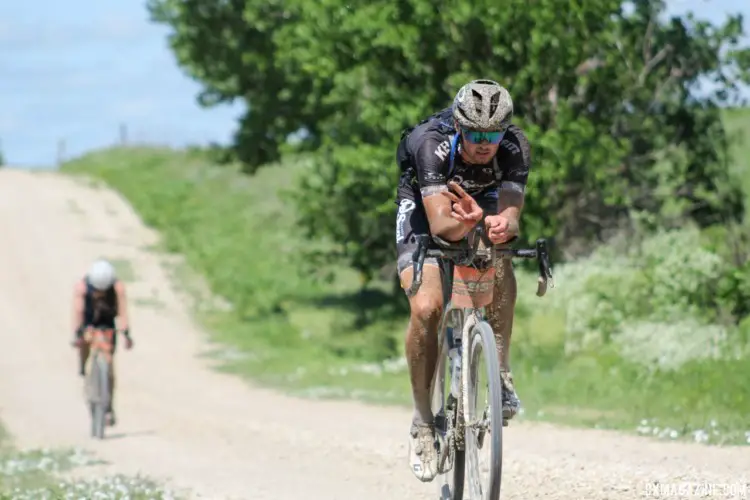
This aero rider was still feeling friendly at mile 80. 2018 Dirty Kanza 200. © Z. Schuster / Cyclocross Magazine
Check Out the Checkpoints
Like many gravel events, the Dirty Kanza allows riders to receive dedicated assistance at only three designated checkpoints located in Madison, Eureka and again in Madison. The race is so long and the course so challenging, the event requires DK200 riders to have a dedicated support crew. The thing that sets the Dirty Kanza 200 apart from your local race was the sheer scale of the checkpoints designed to get 1,000 riders resupplied and back on their way in a short period of time.
In short, the checkpoints were a spectacle to behold and a must-see for anyone who attends the Dirty Kanza as a spectator.
The first checkpoint was in the parking lot of the Madison High School. Cars were backed up getting in the parking lot like it was a fall Friday night and once in the scrum of cars, support crews lined the designated riding lane, waiting for the first sight of the lead group of riders.
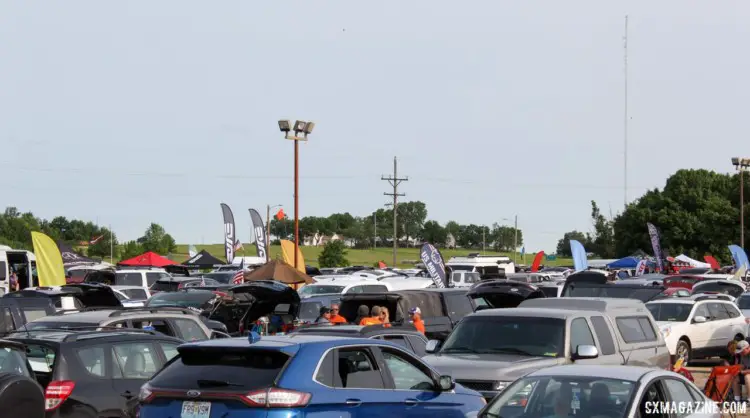
The parking lot at Madison High School, location of Checkpoint 1, looked like it was a fall Friday night. 2018 Dirty Kanza 200. © Z. Schuster / Cyclocross Magazine
When riders finally arrived, some went straight to their teams, while others looked for their friends and teammates giving up their Saturday to help them in their Kanza journey. There is no question that one place experience at the Dirty Kanza shows is at the three checkpoints.
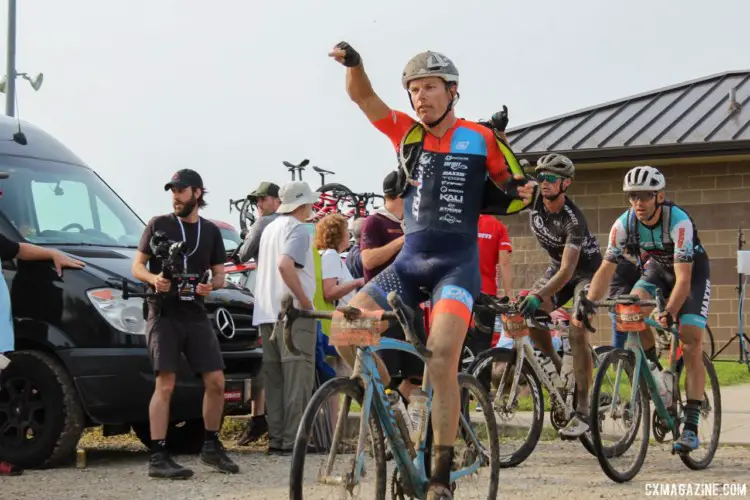
The first step in a good pit stop is finding your pit crew, which was easier said than done at times. 2018 Dirty Kanza 200. © Z. Schuster / Cyclocross Magazine
Admittedly, in retrospect, I wish I had delved into the story of the pit crews more. If I return to Kanza in 2019, you can count on a trip into the pit being part of our coverage.
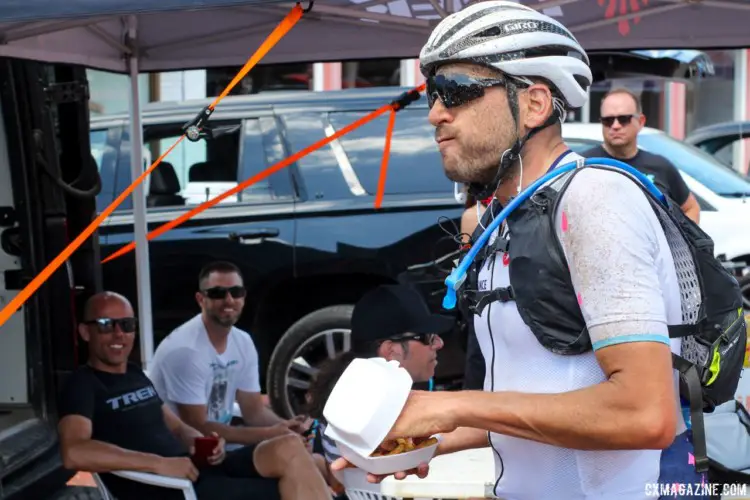
Sven Nys clearly approved of frites as a Checkpoint 3 fuel source. 2018 Dirty Kanza 200. © Z. Schuster / Cyclocross Magazine
Pit crews seemed to have between one and three team members to help riders out. The fully manned teams had a bike stand and a waiting mechanic, one person to swap out bottles and hydration packs—the latter of which are seemingly a must-have for the Dirty Kanza—and another to get the rider food and cram gels and bars into their bar bags.
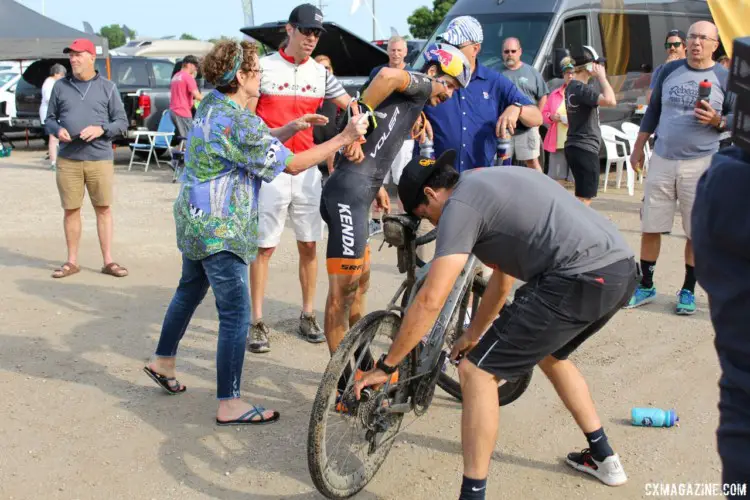
Payson McElveen’s team helps him at Checkpoint 1. 2018 Dirty Kanza 200. © Z. Schuster / Cyclocross Magazine
The official Dirty Kanza 200 rules state riders must start and finish on the same frame. As we saw in our profile of Sven Nys’ Checkpoint, his team swapped wheels for him after he suffered a tread puncture early in the race.
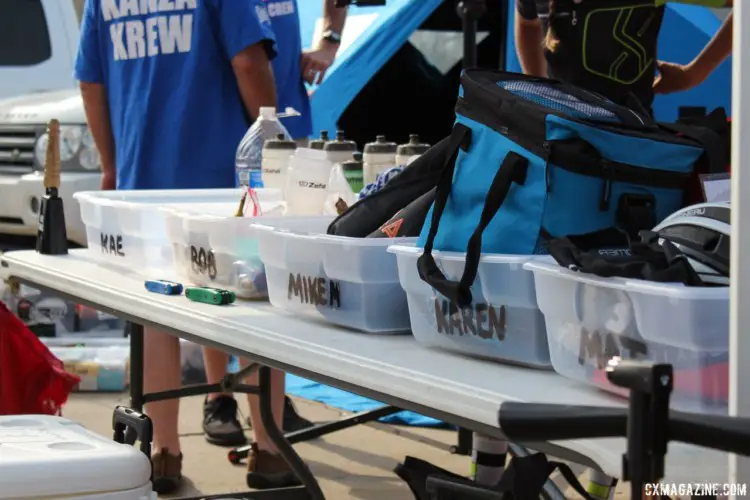
The Panaracer team had their setup dialed in for each of its riders. 2018 Dirty Kanza 200. © Z. Schuster / Cyclocross Magazine
The biggest technical challenge early on appeared to be dealing with the massive amount of grit that accumulated in riders’ drivetrains. Squeaks were aplenty, and by checkpoint 3, one team I watched just doused their riders’ chain with like half a bottle of lube. Not ideal, but at mile 160, the mission was more about finishing than anything else.
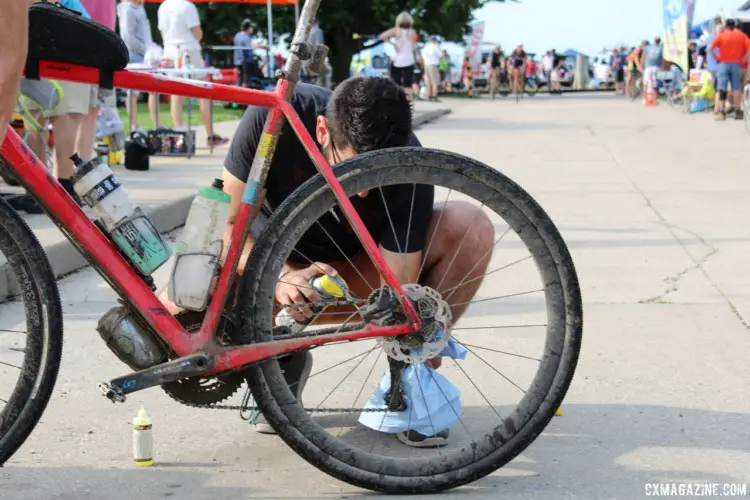
Chain lube was a must-have at the checkpoints. A pit crew member lubes his rider’s bike up at Checkpoint 1. 2018 Dirty Kanza 200. © Z. Schuster / Cyclocross Magazine
Teams with less pit crew members doubled up on duties, and for them, bike maintenance seemed less common. The lesson seemed to be that if you have a mechanic friend, convince them to come with. Kaitie Keough’s team of her dad and his friend were easy to spot thanks to the bright green Cannondale p/b CyclocrossWorld jersey her dad was wearing.
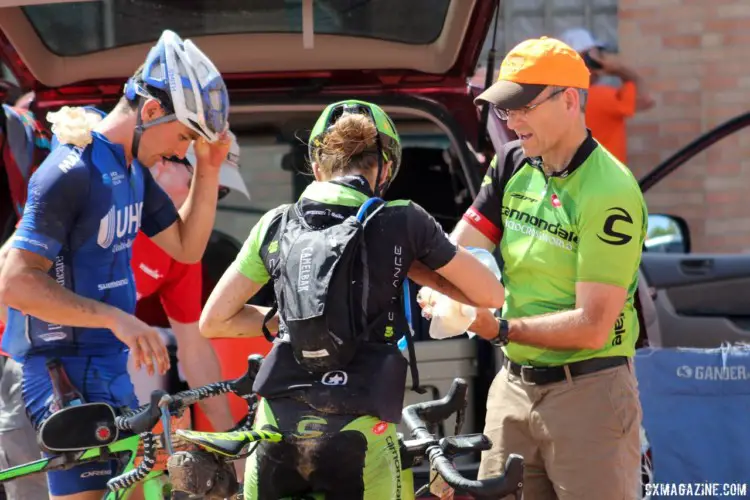
Kaitie Keough had an easy time finding her pit crew with her dad clad in a Cannondale kit. 2018 Dirty Kanza 200. © Z. Schuster / Cyclocross Magazine
Even though the checkpoints were the only place riders were allowed to receive assistance from their pit teams, the goal of most was to get in and out as quickly as possible. With many riders arriving with groups at the first two checkpoints, a slow pit could mean at best having to burn matches chasing back and at worst, getting dropped as the others sped away. This was seen with the lead group at checkpoint 2, as a group of 10 split into groups of 3, 5 and the then the chasers after the stop in Eureka.
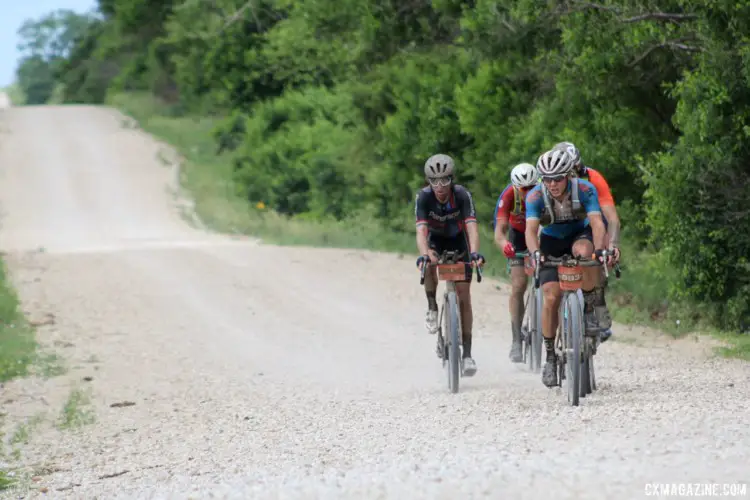
Things in the lead group broke apart after the second checkpoint. This group chased the leaders. 2018 Dirty Kanza 200. © Z. Schuster / Cyclocross Magazine
Caulk the Wagons and Ford the River
As a DK newb, I did my best to develop a race-chasing strategy. I settled on assuming and average pace of 20mph for the leaders and guessing which spots I could beat them to without driving on the actual course. Even the B roads were more of less one-lane wide, so I did not want to be that guy who ran into a rider.
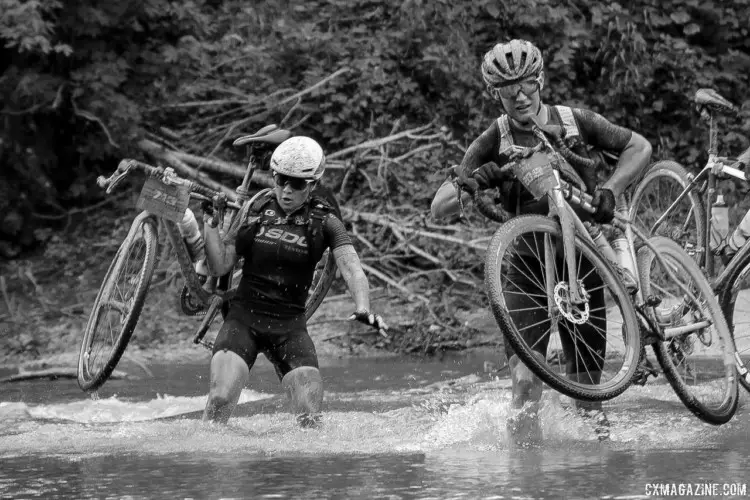
Amanda Nauman narrowly avoided a trip to the drink at the creek crossing. 2018 Dirty Kanza 200. © Z. Schuster / Cyclocross Magazine
I lucked into the Walnut Creek crossing at Rocky Ford. After the race, fellow race-chaser Ethan Glading was impressed I found the spot; I had to admit it was pure luck. I actually drove on the course when I found it, only to reach the crossing and decide to turn around and approach from the other side. The approach for the riders was a tree-lined one-lane descent, so as I backtracked, I was freaking out that Ted King and Josh Berry might crash into my car.
Fortunately, they did not.
I made it to the other side and joined the folks congregated there. The crossing was an interesting one because it is located at a bend that opens up on the other side without a clear exit point. The lower level has a stone culvert that seemingly goes … somewhere … and a hill out of the small valley located to the left of the culvert. The ambiguity of the crossing created some entertaining moments with the riders at a certain level of delirium 130 miles in.
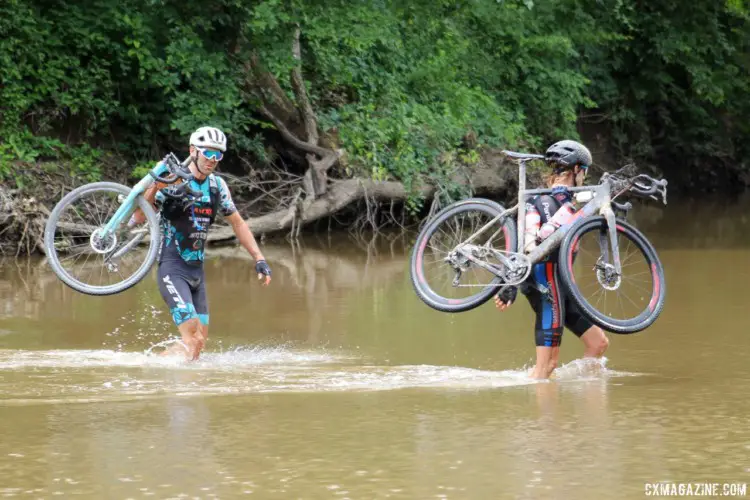
Geoff Kabush let his aero bar frenemy Mat Stephens do the work at the creek crossing. 2018 Dirty Kanza 200. © Z. Schuster / Cyclocross Magazine
When the two leaders King and Berry reached the crossing, King stopped to ask for directions. With both men clad in white Velocio kits, at first I thought it was Berry since he was the DK200 rookie.
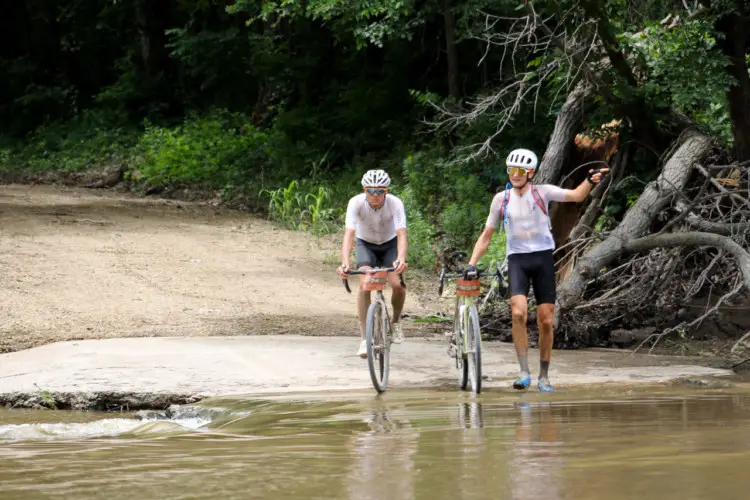
Ted King asks for directions at the Rocky Ford. 2018 Men’s Dirty Kanza 200. © Z. Schuster / Cyclocross Magazine
A former cyclocross racer, Berry decided to ford the river the old-fashioned way.
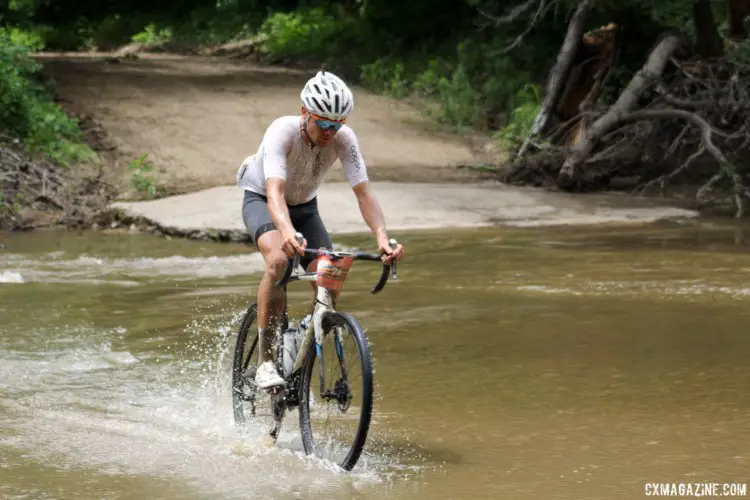
Josh Berry used his ‘cross skills to ride the crossing. 2018 Dirty Kanza 200. © Z. Schuster / Cyclocross Magazine
When Kaitie Keough made her way through the crossing, she asked if the tunnel was the way out of the creek valley. (Apparently it goes to private property decidedly not on the course). Other riders took advantage of the chance to cool off.
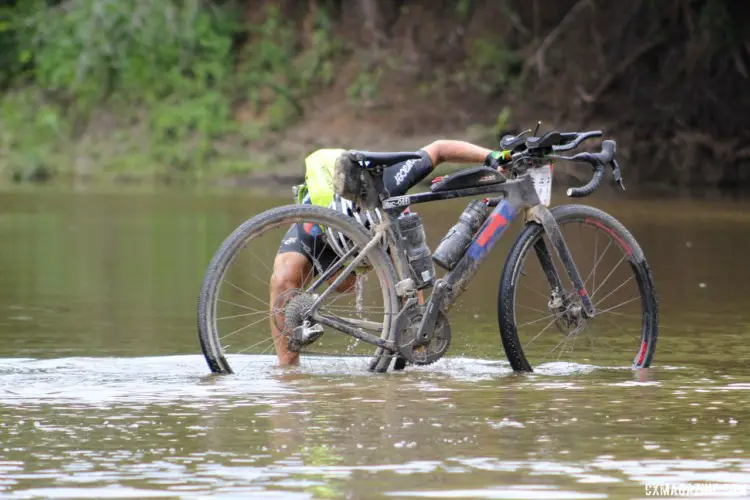
The creek crossing provided a good spot to cool off. 2018 Dirty Kanza 200. © Z. Schuster / Cyclocross Magazine
One rider asked the group of media, volunteers and spectators if he should ride the crossing. We, of course, said yes. He did not make it. Sorry, not sorry.
After the mile 130 refresher, riders only had 75 more miles of Kansas headwind and gravel to go.
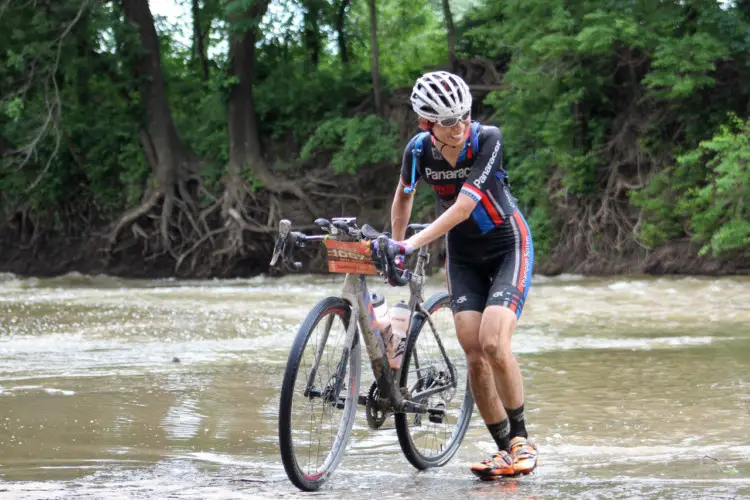
Kae Takeshita crosses Walnut Creek with 75 miles to go. 2018 Dirty Kanza 200. © Z. Schuster / Cyclocross Magazine
A Hero’s Welcome
Another publication labeled the Dirty Kanza as cycling’s Ironman; if the Kanza does share one thing with the Ironman, it is the impressive scene at the finish. Oh wait, how can I forget the aero bars. Let’s try this again. If the Kanza does share a second thing with the Ironman, it is the impressive scene at the finish.
The race finishes on Commercial Street, which runs north-south through downtown Emporia. Barriers stretch a good block or more from the finish near the Granada theater toward the Emporia State campus. Orange cones extend further, providing finishers with a much-awaited orange-cone road home.
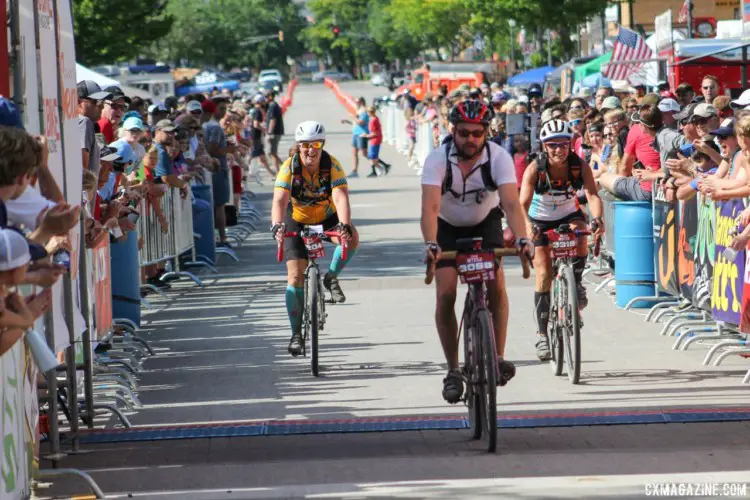
The finish is a chance for riders in all racers to celebrate their accomplishment. 2018 Dirty Kanza 200. © Z. Schuster / Cyclocross Magazine
Based on the one Ironman Wisconsin finish I have seen (which is lazy since it is in my hometown), an announcer yells out “You are an Ironman,” for each finisher. After that level of suffering and achievement, I can only imagine how incredible that feels for each and every finisher.
When I arrived back in Emporia, fans lined the barriers to welcome home riders who were finishing the Dirty Kanza 100 ride. An announcer called out each name as they made their way down the finishing chute.
I was tempted to say they were there waiting for Ted King and Kaitie Keough, but I think they were there to welcome home all the riders who were finishing. Yeah, there was a marquee race, but heart and soul of gravel events are the amateur participants, and the Dirty Kanza crowd knew it. DK100 finishers gave fans high fives, and local Emporians received extra-loud cheers from the crowd.
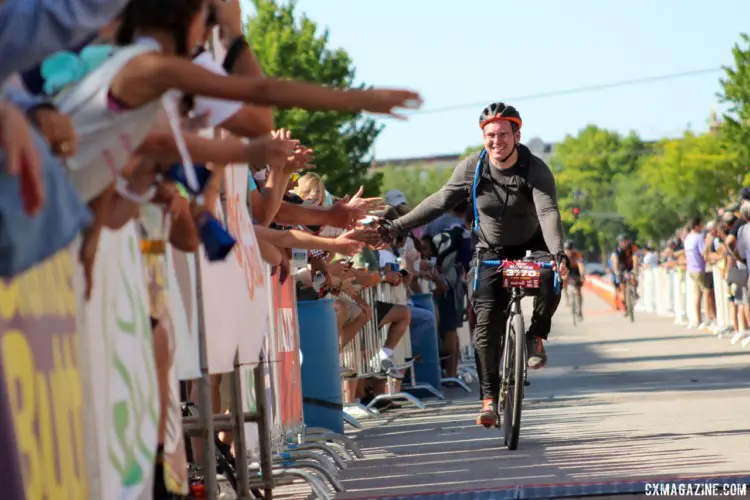
Fans and finishers welcome home everyone who finishes the Dirty Kanza. 2018 Dirty Kanza 200. © Z. Schuster / Cyclocross Magazine
In the finish chute, each finisher received a card commemorating their accomplishment, whether they be Ted King or a DK100 finisher on a hybrid. Sound kind of participation trophyish? The card entitled finishers to free beer from the local Free State Brewery, so damn straight they got a participation trophy. A very tasty and refreshing participation trophy.
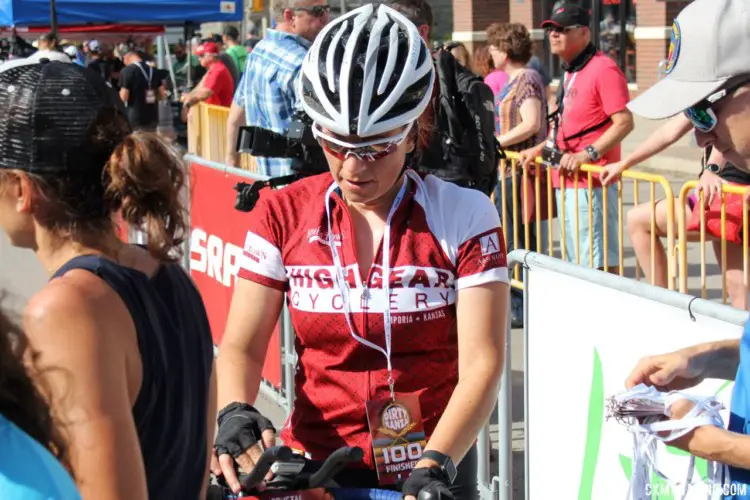
Each finisher received a finisher card that entitled them to a participation trophy from Free State Brewing. 2018 Dirty Kanza 200. © Z. Schuster / Cyclocross Magazine
I cannot say enough about the scene at the finish. Like a hundreds of people were gathered at and around the barriers in Emporia to celebrate bikes, testing personal limits and the gravel community. People hugged, shared stories, celebrated, cried, smiled, signed the finisher board and cheered on fellow finishers.
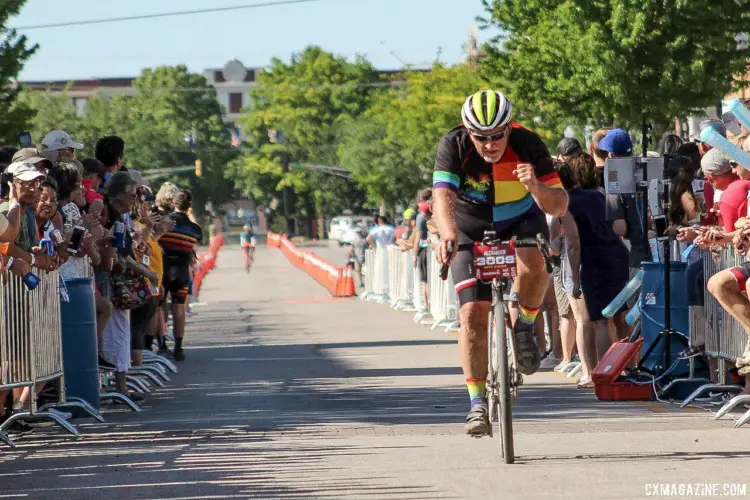
Everyone gets the chance to celebrate at the Dirty Kanza finish. 2018 Dirty Kanza 200. © Z. Schuster / Cyclocross Magazine
Oh, they also told anyone who would listen they’re never doing that again. (They’ll be back in 2019, yes they will.)
Final Thoughts
If you have read this far, thanks! But I’m sorry. But most of all thanks.
I have been riding in gravel events since 2014, but this year—thanks in part to my job—is the first I have gone all-in on gravel riding. I think the beauty of gravel is that events—whether they be called “races,” “rides,” “grinders,” “fondos” or whatever—let each racer choose how they want to participate.
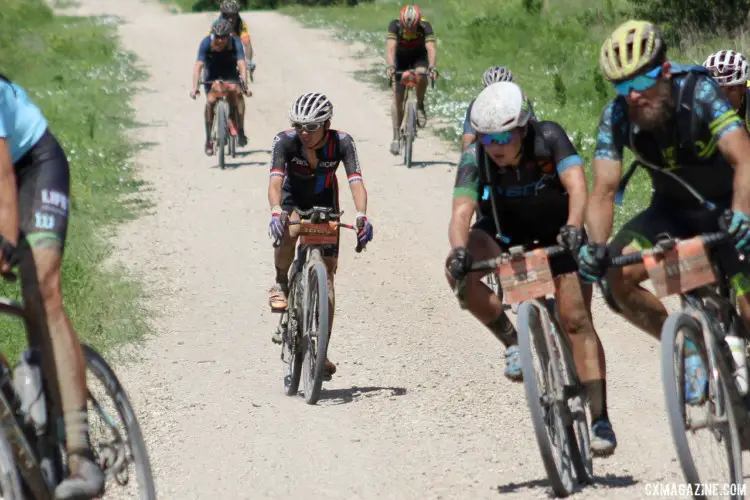
Gravel events provide a chance for women and men to ride the same distance in one mass start field. 2018 Dirty Kanza 200. © Z. Schuster / Cyclocross Magazine
Want to race to win? Go hammer at the front. Want to set a personal record? Train and go for that PR. Aiming to just finish? Start near the back, enjoy the ride and company and stop for those bacon hand-ups. Riding the DK200 on a tandem? Props to you, crazy people!
The point is, an event can be all these things at the same time, and gravel racing has proven that. Hang out at the finish of a gravel event, and you will hear each person tell their story, whether they podiumed or finished 857th. The groups they rode with, the moments they didn’t think they would finish, how they wish they had ridden the creek. If you have never been, the finish of a gravel race is a good place to be.
Returning to the internet on Monday, the cycling commentariat was abuzz about the DK200, which let’s be honest, is a testament to the event’s success. There were the controversies, sure, but beneath that, it seemed there was a lot of snark and negativity about gravel and the DK200. It was a stark contrast to the celebration of bikes and community in Emporia I had just returned from.
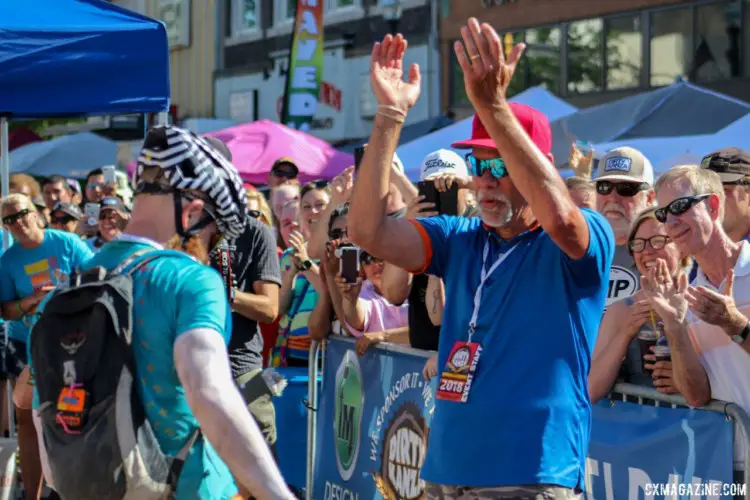
All riders received a hearty welcome home. Here, race director Jim Cummin welcomes DKXL winner Matt Acker. 2018 Dirty Kanza 200. © Z. Schuster / Cyclocross Magazine
In an industry where we have to define everything and make rules because someone might be a jerk, it’s almost like it’s threatening that a group of adults can get together and race or ride their bikes while working with one another, even during a race. Race leaders can agree to stop and take a picture at the Salsa Chaise Lounge without screwing each other over, groups wait for riders if they have to stop for a car, riders help each other out if they’re in trouble. The list goes on.
In my opinion, gravel racing does not need to be defined. It can simultaneously be fun, challenging, a race, an adventure, grassroots, organized, and most of all, a celebration of a community of people who like to ride their bikes.
To go back to the questions I asked at the beginning of this piece, can an event be both successful and grassroots? I think the Dirty Kanza proves it can. Yeah, the event was professionally produced and there were rules here and there, but to me it felt like the Almanzo 100 in Minnesota or even the Bear 100 in the middle of nowhere northern Wisconsin but with thousands more gravel friends.
I am already looking forward to going back in 2019. If you are a gravel enthusiast and have not been, I recommend checking it out. Oh, you’re going to race the DK200? Mad props to you, mad props to you.


























